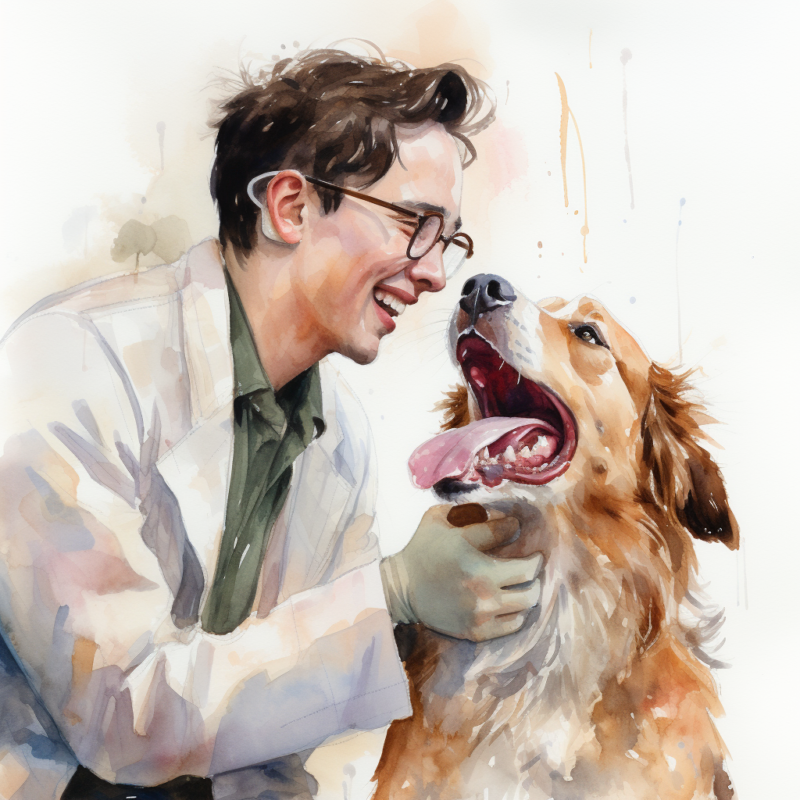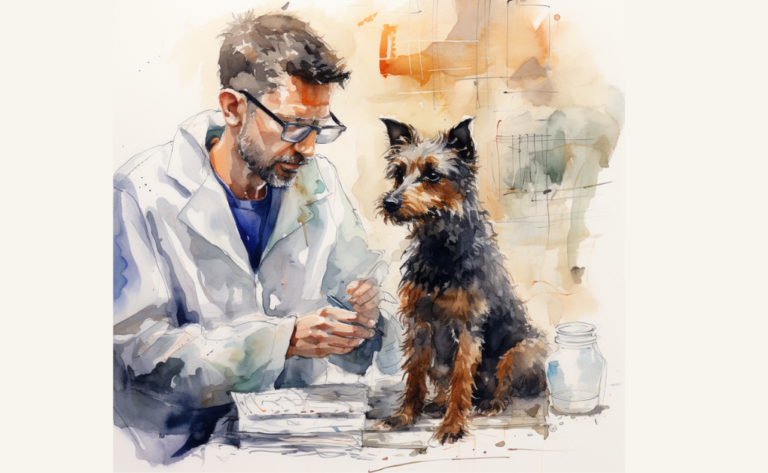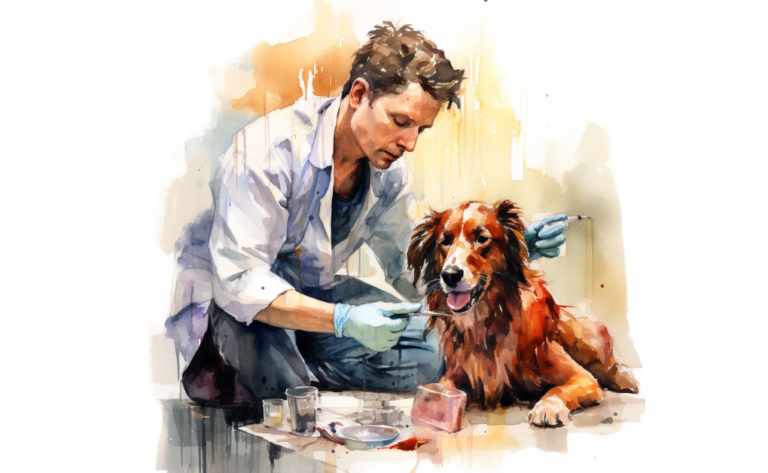Gum Disease in Dogs: Exploring Canine Periodontal Health
What is it?
How is it Treated?
Breed Predispositions
Chihuahua Pomeranian Toy Poodle Yorkshire Terrier Maltese Dachshund Shetland Sheepdog Cavalier King Charles Spaniel Greyhound Afghan Hound
Introduction
Sarah had always been proud of her dog, Cooper, a handsome and energetic Border Collie with a radiant smile. However, she recently noticed that his breath was increasingly foul, and his once pearly white teeth were now discolored and covered in plaque. Knowing the importance of dental health, Sarah wasted no time in taking Cooper to their family veterinarian for an examination. The vet’s diagnosis was clear: Cooper was suffering from periodontal disease, a common yet potentially severe oral health problem in dogs.
Periodontal disease, often called gum disease, is a common disease in dogs that leads to inflammation and injury to the soft tissue and bone that support a dog’s teeth. This disease is typically triggered by an accumulation of plaque and tartar below the gum line on the tooth’s surface, which can cause an infection. If left untreated, this infection can spread to other parts of the mouth, eventually leading to tooth loss and more severe health conditions.
The American Academy of Periodontology describes periodontal disease as a chronic inflammatory condition that impacts the structures tasked with supporting the teeth, highlighting its role in overall health. It is estimated that periodontal disease, common in dogs, affects approximately 80% of dogs aged three and over. This suggests that most dogs, even those that show signs of periodontal disease, don’t escape their grip at some point.
Types of Periodontal Disease in Dogs
There are three types of periodontal disease: gingivitis, periodontitis, and apical periodontitis.
- Gingivitis is milder than periodontitis, and it causes redness and swelling of the gums and makes regular tooth brushing difficult. Gingivitis usually starts with plaque buildup under the gumline. Over time, bacteria multiply and form tartar, causing the gums to become inflamed. With gingivitis, there is no bone loss or tooth attachment.
- Periodontitis is often called adult periodontitis because it typically develops during adulthood. Deep pockets between teeth and gums, loose teeth, and bone loss characterized loss. Periodontitis is caused by bacterial infections that destroy the soft tissues and bones supporting teeth.
- Apical periodontitis is much rarer than other periodontal diseases. It happens when infected teeth spread into the tooth’s root canal system. Apical periodontitis can occur in people with healthy gums and regular dental hygiene. However, it can cause chronic pain and can damage the jawbone.
Causes of Gum Disease in Dogs
The primary cause of dog periodontal disease is the accumulation of bacteria in the dog’s oral cavity. These bacteria merge with saliva and food remnants, forming a sticky plaque that clings to the dog’s tooth. As time progresses, this plaque solidifies into tartar, a tough substance that adheres to the teeth, potentially advancing under the gum line.
This area becomes a hospitable environment for further bacterial growth. The presence of bacteria, plaque, and tartar aggravates the gums and nearby tissues, instigating inflammation or gingivitis, marking where periodontal disease begins.

Numerous factors can shape the onset and intensity of dog periodontal disease. These factors include age, breed, diet, oral hygiene, and excessive grooming habits. For example, as dog’s age, they become more susceptible to gum disease, especially if oral hygiene is not consistently practiced. In addition, specific breeds, particularly smaller ones or those with crowded teeth, are more prone to periodontal disease due to their mouth structure. Dietary habits are another key component; a diet primarily composed of soft or wet food might promote plaque and tartar formation, given these food types stick to the teeth more readily than dry kibble.
The dog’s overall health and immune status can also dictate the progress of the periodontal disease. For instance, dogs suffering from immune-mediated diseases or conditions that hamper the body’s ability to resist infections may be more vulnerable to a severe or swift advancement of periodontal disease. Likewise, dogs with chronic conditions like diabetes could face an elevated risk of periodontal disease due to changes in gum blood flow and shifts in oral bacteria. These factors combined emphasize the necessity of routine veterinary care and good oral hygiene practices, such as giving your dog regular teeth cleanings.
Studies reveal that almost 90 percent of dogs will develop some form of periodontitis by age two. This common dental disease is one reason we must prioritize our furry friends’ dental health as early as possible to prevent periodontal disease. In severe cases, unchecked periodontal disease can cause jaw fractures and problems for dogs with organ conditions, highlighting its potentially far-reaching effects.
Stage 1: Gingivitis
During the initial stage of periodontal disease in dogs, the signs and symptoms are typically mild. They may encompass bad breath and inflamed gums, contributing to a dog’s reluctance to consume hard foods. However, the outlook is positive at this stage, with proper dental care and frequent cleaning to eradicate plaque and tartar, ensuring your dog’s mouth remains healthy.
Stage 2: Early Periodontitis
At the onset of periodontitis, there is amplified inflammation and gum erosion. Signs of this stage may include bad breath, visible tartar, drooling, and possible alterations in eating or chewing patterns. However, the prognosis is still favorable, with professional dental cleanings and care necessary to maintain good oral health.
Stage 3: Moderate Periodontitis
As we progress to the intermediate periodontitis stage, symptoms intensify. These include persistent bad breath, evident tartar, gum recession, and bleeding gums. Dogs may also demonstrate discomfort, such as pawing at their mouth or difficulty eating. At this juncture, the prognosis becomes more cautious as irreversible damage might have already occurred, but professional dental treatments can help manage the disease in your dogs.
Stage 4: Advanced Periodontitis
The final stage of periodontal disease, severe periodontitis, manifests through pronounced bad breath, rampant tartar, gum erosion, loose or missing teeth, and significant discomfort, which may lead to changes in behavior. Sadly, the prognosis is poor, as considerable and irreversible dental damage has transpired. Nonetheless, regular veterinary care can help manage pain and decelerate the progression of this common disease.”
Diagnosis of Periodontal Disease in Dogs
Diagnosing periodontal disease in dogs entails a blend of physical evaluation and dental diagnostic techniques.
Initially, veterinarians will conduct a comprehensive physical examination of the dog, incorporating a meticulous assessment of the dog’s mouth and teeth. Next, the vet will scout for indications of periodontal diseases, such as red and inflamed gums, bad breath, tartar accumulation, loose or missing teeth, and any sign of discomfort in the dog. Identifying periodontal disease present at this stage can help prevent the need for emergency care later on.
However, additional diagnostic procedures are often necessary to gain a complete picture, as many changes transpire beneath the gum line where they are not instantly visible. These can encompass dental radiographs (X-rays) to evaluate the state of the dog’s teeth and the supporting bone structures beneath the gum line.
These dental radiographs can disclose the existence of periodontal pockets (spaces between the tooth and gum tissue), loss of bone surrounding the teeth, and the overall health of the tooth roots. These elements aid the veterinarian in accurately staging the periodontal disease and deciding the most suitable treatment plan, considering the state of the periodontal tissues.
In certain scenarios, a veterinarian might also carry out periodontal probing. This procedure involves using a unique tool to measure the depth of the gum pockets around a tooth. A deeper pocket could signify a more severe form of the disease.
Blood tests can also help evaluate the dog’s overall health and ascertain if an infection has spread beyond the mouth, vital in more advanced stages of periodontal disease.
It’s crucial to note that a thorough dental examination and X-rays are typically performed under general anesthesia. This practice ensures the dog’s comfort while maintaining the procedure’s safety and effectiveness.
Treatment of Periodontal Disease in Dogs
The plan of action for treating periodontal disease in dogs fluctuates based on the stage of the disease. Here’s a look at how veterinary professionals typically tackle each phase:

Addressing Stage 1 (Gingivitis)
At this stage, periodontal disease is still reversible. A veterinarian, aligned with the Veterinary Oral Health Council standards, will carry out a professional dental cleaning, which includes scaling (eradicating dental plaque and tartar) and polishing the pet’s teeth. Regular teeth cleaning and adherence to an endorsed dental hygiene routine at home, such as daily teeth brushing, are among the best treatment options to prevent disease progression. This is one of the pet care tips that can be easily implemented at home.
Managing Stage 2 (Early Periodontitis)
In addition to professional dental cleaning, the vet might employ subgingival scaling and root planing (also called deep cleaning) to eliminate plaque and tartar beneath the gum line, a method designed to address dental disease. They might also apply antibiotic gels to the gum pockets to exterminate bacteria and stimulate healing.
Approach for Stage 3 (Moderate Periodontitis)
At this point, the disease is more widespread and likely involves irreversible bone loss, marking a transition into stages 3 and 4 of periodontal disease. Along with dental and deep cleaning, periodontal surgery could be required to access and cleanse deeper pockets of infection. In some situations, veterinarians at the animal hospital may utilize regenerative procedures such as bone grafting or guided tissue regeneration. Furthermore, extractions might be essential for severely impacted teeth.
Intervention for Stage 4 (Advanced Periodontitis)
In this advanced stage, the disease causes substantial damage to the dog’s oral health, including significant bone loss. Extracting teeth often becomes necessary to alleviate pain and eradicate sources of ongoing infection. Following surgery, the proper treatment emphasizes pain management and control of secondary bacterial infections.
Regardless of the stage, veterinarians will underline the importance of continuous home care and regular veterinary dental check-ups to help manage the disease and prevent its progression. Additionally, the vet may advise special diets, dog food and chew toys, or dental treats that aid in cleaning the dog’s teeth and consistent tooth brushing.
Remember that early detection and intervention are vital in managing periodontal disease. If you observe any signs of oral discomfort in your dog or changes in eating behavior, consult a veterinarian immediately. These steps ensure gum disease is treated promptly with the best treatment available.
Consequences of Untreated Periodontal Disease in Dogs
Periodontal disease in dogs can lead to various complications if left untreated. These complications may include:
- Tooth loss: Advanced periodontal disease can destroy the tissues supporting the teeth, leading to loose or missing teeth.
- Oral pain: Inflamed gums and dental infections can cause significant pain and discomfort for dogs, making it difficult for them to eat, chew, and enjoy their meals.
- Gum infections: Bacterial infections associated with periodontal disease can spread to the gums, causing gingivitis and more severe gum infections.
- Abscesses: Pockets of pus may form in the gums or around the tooth roots, resulting in painful abscesses.
- Jawbone damage: Severe periodontal disease can affect the underlying jawbone, leading to bone loss and weakening of the jaw structure.
- Systemic health issues: The bacteria associated with periodontal disease can enter the bloodstream and potentially affect other organs, leading to systemic health problems such as heart, liver, or kidney disease.
- Bad breath: One of the common signs of periodontal disease is persistent bad breath (halitosis) caused by the accumulation of bacteria and decaying food particles in the mouth.
Prevention of Periodontal Disease in Dogs
Preventing periodontal disease in dogs requires home care and professional veterinary attention.
Consistent Tooth Brushing
One of the most effective strategies to prevent periodontal disease involves regular tooth brushing, specifically for dogs. This practice helps eliminate the plaque that can solidify into tartar and subsequently lead to periodontal disease. Employ a dog-friendly toothpaste and toothbrush, and strive to brush your dog’s teeth daily.
Specially Formulated Diets and Treats
Certain diets and treats have been uniquely created to assist in cleaning a dog’s teeth while they eat. These can supplement tooth brushing quite effectively. Additionally, dental diets and dog treats foster oral health by reducing plaque and tartar accumulation on the teeth. Here are a few examples:
- Hill’s Prescription Diet t/d Dental Care for Dogs: This special kibble is engineered to resist breaking apart, thus scrubbing the surface of the teeth as the dog consumes it, helping to prevent plaque build-up.
- Royal Canin Veterinary Diet Dental Dry Dog Food: This particular diet features specially designed kibble with a unique texture that promotes chewing and assists in reducing plaque and tartar formation.
- Purina Pro Plan Veterinary Diets Dental Chewz Dog Treats: These long-lasting, protein-rich, flavorful chews help diminish tartar accumulation for improved dental health.
- Greenies Dental Dog Treats: Greenies are dental chews recommended by vets with a unique texture designed to combat plaque and tartar along the gum line.
- Milk-Bone Brushing Chews: These daily dental treats are engineered to remove harmful plaque and tartar and carry the Veterinary Oral Health Council (VOHC) Seal of Acceptance.
- Whimzees Natural Grain-Free Dental Dog Treats: These vegetable-based treats feature a unique shape and texture to assist in removing plaque and tartar as the dog chews.
- Pedigree Dentastix Dental Treats for Dogs: Dentastix is an X-shaped dental treatment that helps to reduce plaque and tartar build-up when incorporated into a daily oral care regimen.
Dental Toys
A broad range of toys on the market is designed to clean dogs’ teeth while playing. These toys can effectively promote dental hygiene in dogs resistant to tooth brushing. Here are a few examples:
- Chew Toys: These toys, usually crafted from durable rubber or nylon, may feature grooves, bumps, or nubs that assist in cleaning the teeth and gums as the dog chews.
- Dental Chews or Edible Dental Toys: These are toys that dogs can chew and consume. They are typically made from soft abrasive materials to help clean teeth, and some are formulated with enzymes or other components that promote dental health.
- Dental Sticks: These resemble dental chews but are usually stick-shaped. They can be crafted from various materials, including edible substances like rawhide or vegetable-based compounds. Their chewing action can help clean a dog’s teeth.
- Rope Toys: Some rope toys can assist in cleaning a dog’s teeth as the individual threads navigate the spaces between teeth.
Regular Veterinary Visits
Regular dental appointments with your vet are crucial as they can help identify early signs of disease. Additionally, your vet can recommend when professional dental cleaning is needed.
Professional Dental Cleanings
Professional dental cleanings under anesthesia represent the highest standard in preventive dental care. This procedure allows for a comprehensive cleaning above and below the gum line and aids in preventing periodontal disease progression.
Remember, these preventative steps aim to preserve your dog’s oral health, which may contribute to your pet’s overall health. As pet owners, it’s best to consult your vet about the most suitable dental care plan for your dog, including appropriate dog food and chew toys.
Frequently Asked Questions
Disclaimer: The information provided on this veterinary website is intended for general educational purposes only and should not be considered as a substitute for professional veterinary advice, diagnosis, or treatment. Always consult a licensed veterinarian for any concerns or questions regarding the health and well-being of your pet. This website does not claim to cover every possible situation or provide exhaustive knowledge on the subjects presented. The owners and contributors of this website are not responsible for any harm or loss that may result from the use or misuse of the information provided herein.







